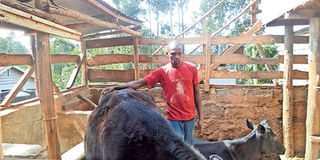Dairy app, Love for animals and hard work: A young farmer’s recipe for success

Stanley Kiarie in his dairy farm in Kinoo, Kiambu County. He gets at least 12 litres of milk per cow daily with the top producer offering 18 litres. PHOTO | WINNIE LELEI | NMG
What you need to know:
- James Kiarie, a dairy expert at DigiCow, an app that Kiarie uses, says that forage should be cut to the right size because finely chopped fodder can cause depressed butterfat content in milk.
- For Kiarie, his typical day starts at 5:40am with milking. The milk is weighed and put into different containers depending on orders.
- Once the cleaning is done, the rest of the cattle are given their feed to allow them plenty of time to rest and digest before the next milking time that starts at noon.
- The farmer gets 12 litres of milk per cow daily with the top producer offering 18 litres.
Growing up on a farm in Kinoo, Kiambu County, all Stanley Kiarie had ever known was a life around cattle, waking up every morning to milk and collect pasture.
So when hard times hit and he was forced to work as a casual at building sites, he chose to try cattle keeping — except this time, he would have to farm for money.
In 2017, armed with a cow given to him by his mother, two calves and a barn design from the Kenya Agricultural and Livestock Research Organisation, the 34-year-old constructed the structure with a capacity of six adult cows and several calves, using timber rails to partition it and concrete blocks for the walls.
He thought he was doing fine until the only cow producing milk started going ‘dry’ and the three litres a day it offered could not sustain his expenses.
“I started consulting other farmers who were doing well in dairy farming on social media. I also came across an app that has been useful in my dairy farming,” says Kiarie.
Kiarie feeds his seven cattle of the Friesian breed and various crosses a variety of feeds and concentrates at each stage of the cycle.
For newborn calves, from birth to two weeks, he offers them milk usually put aside after milking and stored in the fridge. Thereafter, he offers them both milk and dry matter and weans them after eight weeks.
For the lactating cows and those in gestation, he feeds them hay and silage.
He also gives them napier grass that he grows after cutting it into small pieces using his chaff cutter.
RIGHT CALVING DURATION
James Kiarie, a dairy expert at DigiCow, an app that Kiarie uses, says that forage should be cut to the right size because finely chopped fodder can cause depressed butterfat content in milk.
For Kiarie, his typical day starts at 5:40am with milking. The milk is weighed and put into different containers depending on orders.
He then feeds the calves at 8am before cleaning the units, putting the dung in a pit close to the structure. Once the cleaning is done, the rest of the cattle are given their feed to allow them plenty of time to rest and digest before the next milking time that starts at noon.
“Dung is a non-toxic fertiliser, so I apply it as manure on the napier grass,” says Kiarie, adding the app has enabled him know when the cow is ready to be inseminated, when to start partial milking and the right calving duration as well as the feeding portions and necessary concentrates for each period.
The farmer gets 12 litres of milk per cow daily with the top producer offering 18 litres. He sells some of the 48 litres to his neighbours who pay monthly while the rest is bought by local vendors who sell at Kinoo and Matharu shopping centres.
He sells his milk per cup, with each going at Sh25 earning him Sh50 per litre. Two cups make a litre.
“If you venture into dairy farming because you love animals, you will certainly work hard towards your success and this will in turn bring you the money,” says Kiarie.




